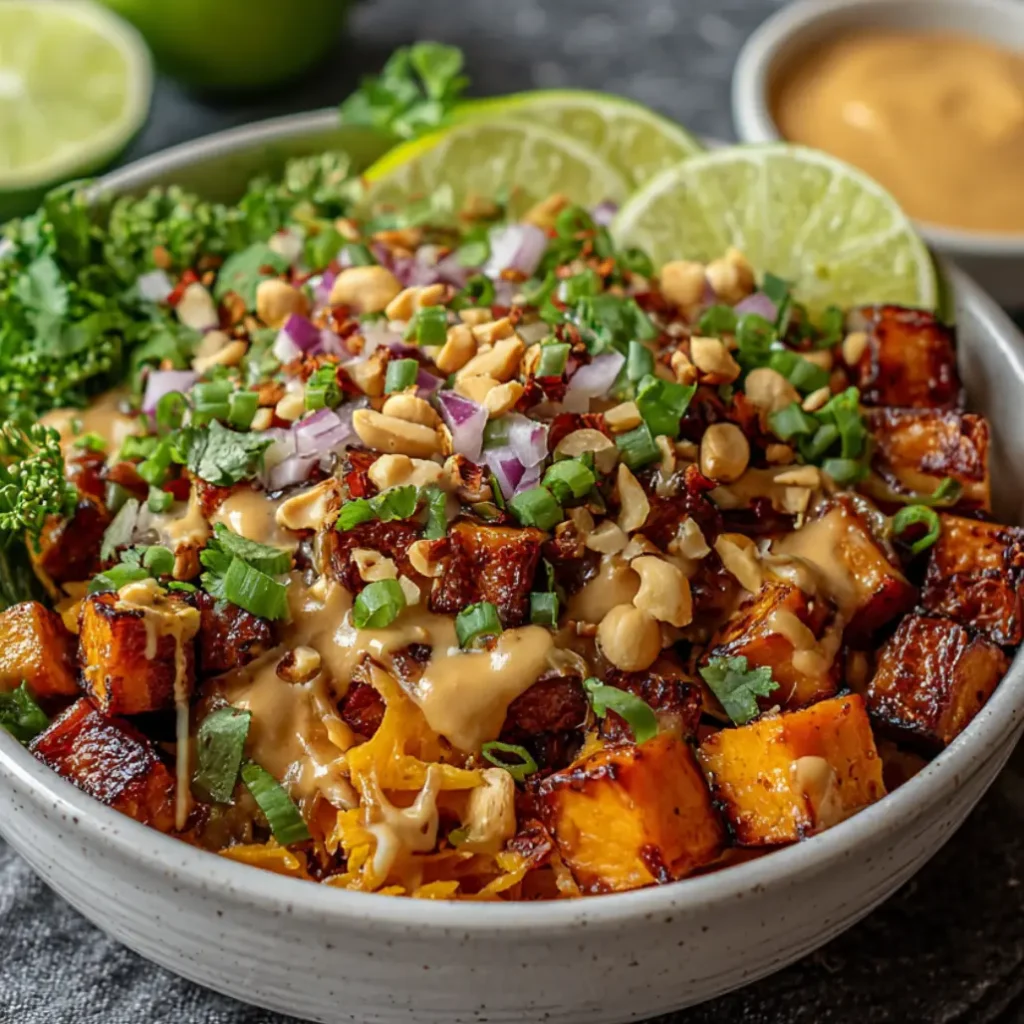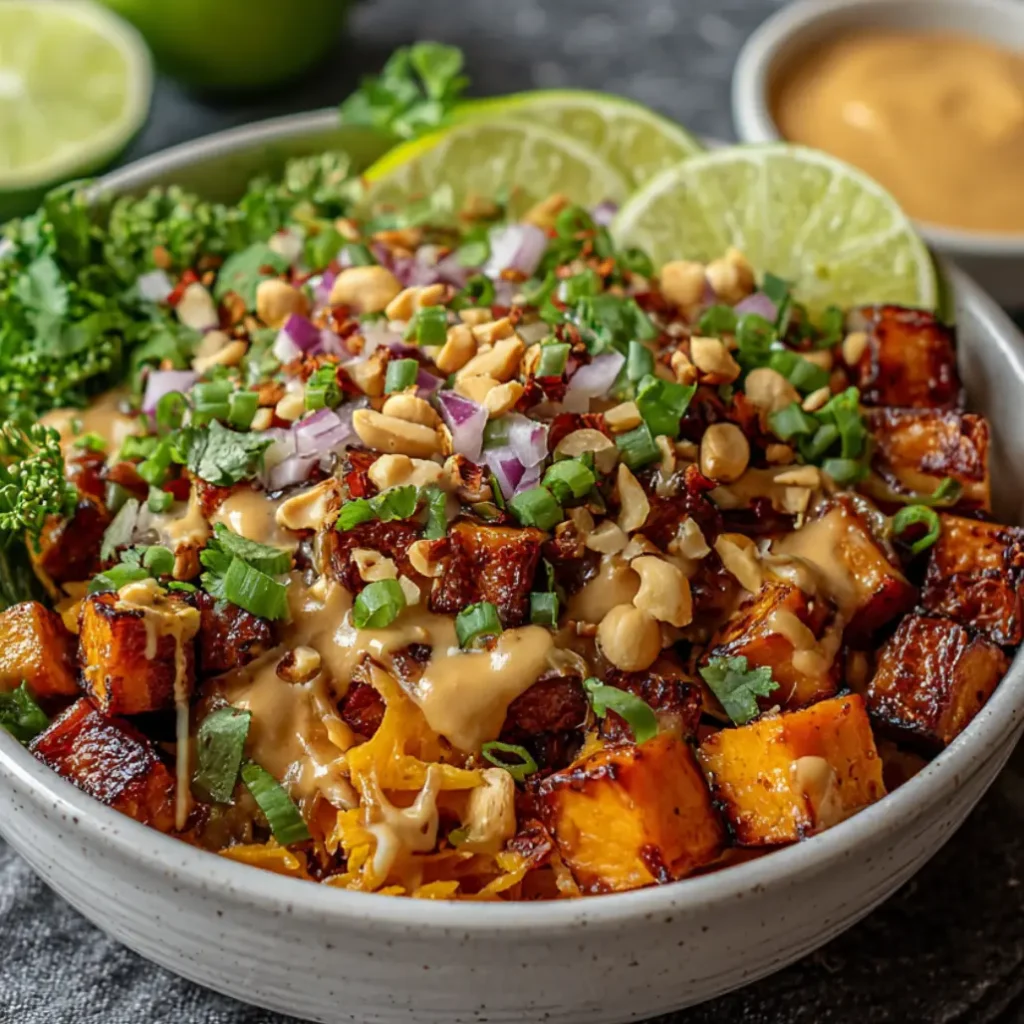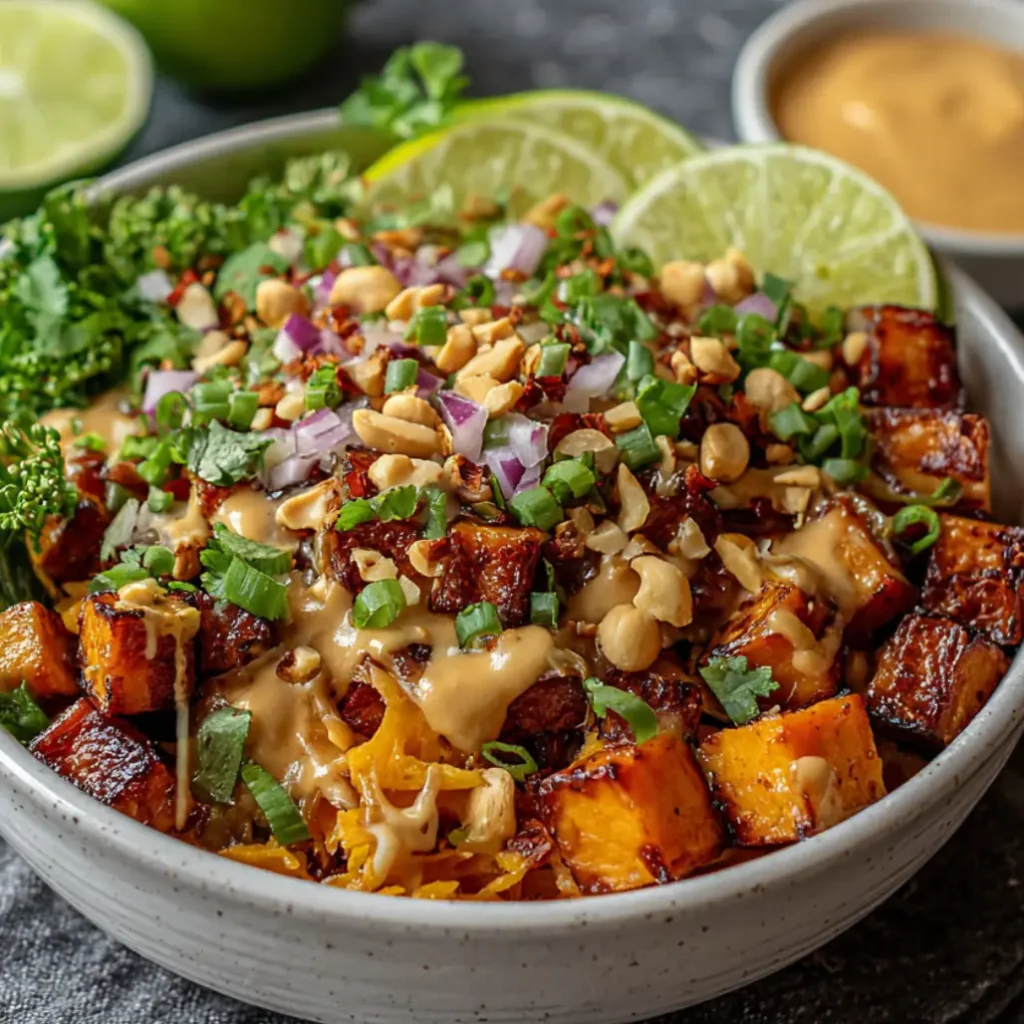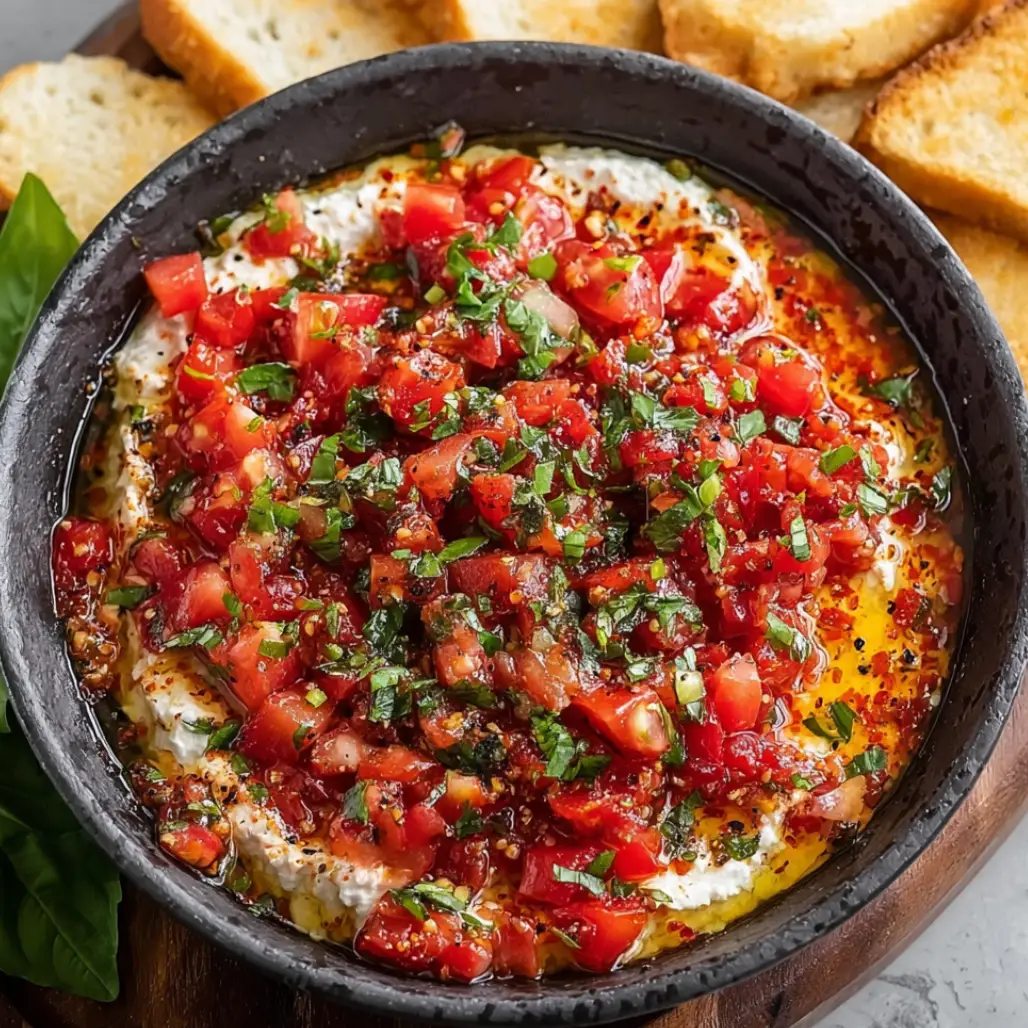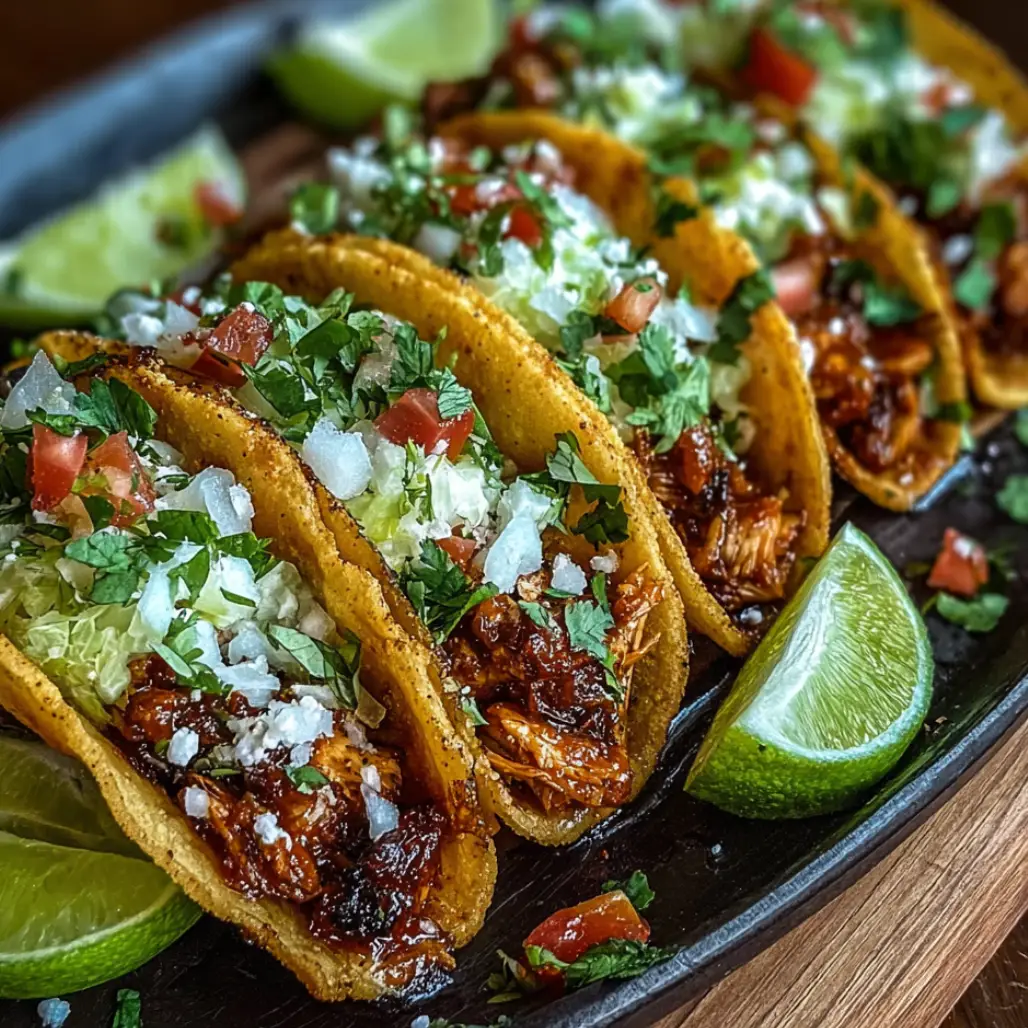| Prep Time: | 15 minutes |
|---|---|
| Cook Time: | 35 minutes |
| Total Time: | 50 minutes |
| Serves: | 4 |
Imagine creating this vibrant Thai peanut sweet potato Buddha bowl that transforms simple wholesome ingredients into a nourishing masterpiece bursting with colors and flavors because this remarkable recipe combines roasted sweet potatoes, fluffy quinoa, crispy chickpeas, and fresh vegetables all drizzled with an irresistible creamy peanut sauce. This stunning Thai peanut sweet potato Buddha bowl delivers the perfect balance of sweet, savory, and nutty elements because it satisfies nutritional needs while providing an Instagram-worthy presentation that makes healthy eating feel like an indulgent treat rather than a sacrifice.
Why Thai Peanut Sweet Potato Buddha Bowl Transforms Meal Time
This exceptional Thai peanut sweet potato Buddha bowl works magnificently because it combines complete nutrition with bold Asian-inspired flavors that satisfy every craving while supporting wellness goals effortlessly. The naturally sweet roasted potatoes provide complex carbohydrates and fiber because they deliver sustained energy throughout the day, while the protein-rich chickpeas offer plant-based sustenance that keeps you feeling full and satisfied for hours.
The genius of this Thai peanut sweet potato Buddha bowl lies in its remarkable adaptability because you can customize every component according to seasonal availability, dietary preferences, and personal taste while maintaining the essential character that makes this dish so beloved. The creamy peanut sauce ties everything together because it provides richness and umami depth that transforms simple vegetables and grains into an extraordinary culinary experience that rivals your favorite takeout restaurant.
The meal prep potential proves invaluable because this Thai peanut sweet potato Buddha bowl stores beautifully for several days, allowing busy individuals to enjoy restaurant-quality meals without daily cooking commitments. The combination of textures creates sensory excitement because each spoonful delivers tender sweet potatoes, crunchy vegetables, fluffy grains, and crispy chickpeas all harmonizing in perfect balance.
Essential Ingredients for Perfect Thai Peanut Sweet Potato Buddha Bowl
For the Roasted Components:
- 2 large sweet potatoes, peeled and cubed into 1/2-inch pieces
- 1 can (15 ounces) chickpeas, drained and rinsed
- 2 cups broccoli florets
- 2 tablespoons avocado oil
- 1 teaspoon garlic powder
- 1 teaspoon paprika
- 1/2 teaspoon salt
- 1/4 teaspoon black pepper
For the Bowl Base:
- 1 1/2 cups uncooked quinoa or brown rice
- 3 cups vegetable broth
- 2 cups fresh baby kale or spinach
- 1 cup shredded purple cabbage
- 1 large ripe avocado, sliced
- 1/2 cup shredded carrots
For the Thai Peanut Sauce:
- 1/2 cup natural creamy peanut butter
- 3 tablespoons coconut aminos or low-sodium soy sauce
- 2 tablespoons fresh lime juice
- 2 cloves garlic, minced
- 1 tablespoon maple syrup
- 1 teaspoon fresh ginger, grated
- 1/4 to 1/2 cup water for consistency
- 1/4 teaspoon red pepper flakes
For Garnish:
- 1/3 cup roasted peanuts, chopped
- 1/4 cup fresh cilantro, roughly chopped
- 2 green onions, thinly sliced
- 1 tablespoon sesame seeds
- Lime wedges for serving
The Art of Creating Thai Peanut Sweet Potato Buddha Bowl
Mastering this beautiful Thai peanut sweet potato Buddha bowl requires understanding the relationship between roasting temperatures, cooking times, and ingredient preparation because successful execution depends on achieving optimal texture for each component. The roasting process caramelizes the natural sugars in sweet potatoes because high heat creates crispy exteriors while maintaining creamy interiors that provide textural contrast.
The grain preparation establishes the foundation because properly cooked quinoa or rice should be fluffy and separate, providing the perfect base for absorbing the flavorful peanut sauce. The sauce consistency matters tremendously because it should be pourable yet thick enough to cling to ingredients, creating a cohesive eating experience rather than pooling at the bottom of the bowl.
Assembly order affects presentation and functionality because layering ingredients strategically ensures even distribution while maintaining visual appeal that makes the Thai peanut sweet potato Buddha bowl as beautiful as it is delicious. Temperature considerations prove important because combining warm roasted elements with cool fresh components creates dynamic temperature contrast that enhances the overall sensory experience.
Step-by-Step Instructions for Thai Peanut Sweet Potato Buddha Bowl
Step 1: Prepare the Grain Foundation
Rinse quinoa thoroughly under cold water for at least one minute because this removes the natural coating that can create bitter flavors. Combine rinsed quinoa with vegetable broth in a medium saucepan because using broth instead of water adds depth and complexity that elevates the entire dish.
Professional Tip: Bring the liquid to a rolling boil, then reduce heat to low and cover tightly because proper steaming ensures fluffy texture without mushiness.
Key Points: Cook for 15 minutes undisturbed, then remove from heat and let stand covered for 5 minutes because this resting period allows moisture to distribute evenly throughout the grains.
Step 2: Roast the Sweet Potatoes
Preheat your oven to 400°F and line a large baking sheet with parchment paper because this prevents sticking while making cleanup effortless. Toss cubed sweet potatoes with half the avocado oil, garlic powder, paprika, salt, and pepper because even coating ensures uniform flavor distribution and browning.
Professional Tip: Spread sweet potato cubes in a single layer with space between each piece because crowding causes steaming instead of roasting, which prevents the caramelization that creates depth.
Key Points: Roast for 30-35 minutes, flipping halfway through, until fork-tender with crispy golden edges because this texture contrast makes the Thai peanut sweet potato Buddha bowl irresistible.
Step 3: Create Crispy Chickpeas
Pat drained chickpeas completely dry with paper towels because excess moisture prevents crisping and creates soggy results. Toss with remaining avocado oil and a pinch of salt because the coating helps achieve the crunchy exterior that provides textural excitement.
Professional Tip: Add chickpeas to a separate baking sheet during the last 20 minutes of sweet potato roasting because they require less time and overcooking makes them hard rather than pleasantly crispy.
Key Points: Shake the pan halfway through cooking because movement ensures even browning on all sides and prevents burning on the bottom surface.
Step 4: Prepare the Broccoli
Cut broccoli into bite-sized florets of uniform size because consistent dimensions ensure even cooking throughout. Add to the chickpea pan during the last 12 minutes of roasting because broccoli cooks quickly and should remain slightly crisp with tender stems.
Professional Tip: Drizzle lightly with oil and season minimally because over-seasoning raw vegetables concentrates during roasting and can create overpowering saltiness.
Key Points: Remove from oven when edges show light browning because residual heat continues cooking while you assemble the bowls, preventing mushy texture.
Step 5: Craft the Signature Peanut Sauce
Combine peanut butter, coconut aminos, lime juice, minced garlic, maple syrup, and grated ginger in a medium bowl because bringing all ingredients together first allows for proper emulsification. Whisk vigorously while gradually adding water because slow incorporation creates smooth consistency without separation.
Professional Tip: Start with less water and add gradually because you can always thin the sauce but cannot thicken it easily once too much liquid has been added.
Key Points: Taste and adjust seasoning by adding more lime juice for acidity, maple syrup for sweetness, or red pepper flakes for heat because balanced flavors make this Thai peanut sweet potato Buddha bowl truly memorable.
Step 6: Assemble the Beautiful Bowls
Divide cooked quinoa among four serving bowls, creating a generous base because the grain foundation supports all other components. Add a handful of fresh greens directly on the warm quinoa because residual heat gently wilts the leaves without making them soggy.
Professional Tip: Arrange remaining ingredients in separate sections rather than mixing everything together because visual presentation enhances the dining experience and allows diners to customize each bite.
Key Points: Place sweet potatoes, chickpeas, broccoli, shredded cabbage, carrots, and avocado slices in individual portions because this rainbow arrangement makes the Thai peanut sweet potato Buddha bowl visually stunning and appetizing.ù
Professional Tips for Perfect Thai Peanut Sweet Potato Buddha Bowl
Meal prep efficiency improves significantly because you can roast all vegetables and cook grains up to four days in advance, storing components separately in airtight containers. Keep peanut sauce refrigerated in a sealed jar because it thickens when cold and may need a splash of water before serving to restore drizzling consistency.
Temperature preferences vary widely because some people enjoy this Thai peanut sweet potato Buddha bowl completely warm while others prefer the refreshing contrast of cold ingredients with warm sauce. Experiment with both approaches because discovering your personal preference enhances satisfaction and ensures you will make this recipe repeatedly.
Ingredient substitutions expand accessibility because sunflower seed butter works beautifully for those with peanut allergies, while tamari provides gluten-free alternative to soy sauce. Different vegetables succeed equally well because roasted Brussels sprouts, cauliflower, or bell peppers offer delicious variations while maintaining the essential character of this nourishing bowl.
Creative Variations for Thai Peanut Sweet Potato Buddha Bowl
Transform this versatile Thai peanut sweet potato Buddha bowl into exciting alternatives because customization allows you to create new experiences while using the same basic framework. Add protein options like grilled chicken, baked tofu, or seared salmon because animal or plant proteins increase satiety and accommodate different dietary preferences beautifully.
Experiment with grain alternatives because farro, wild rice, or even cauliflower rice provide different textures and nutritional profiles while supporting various eating styles. Try different sauce variations because almond butter, tahini, or cashew butter create unique flavor profiles, while adding sriracha or chili garlic sauce transforms the heat level significantly.
Seasonal adaptations keep the recipe fresh because summer versions might include zucchini and bell peppers, while winter renditions could feature roasted butternut squash and kale. The fundamental concept remains constant because this Thai peanut sweet potato Buddha bowl framework accommodates endless ingredient combinations while maintaining nutritional balance and visual appeal.
Perfect Pairing Ideas for Thai Peanut Sweet Potato Buddha Bowl
This substantial Thai peanut sweet potato Buddha bowl stands beautifully as a complete meal because it provides balanced macronutrients, but strategic pairings enhance the overall dining experience. Start with light appetizers from https://tastymiddles.com/category/snacks-appetizers/ because fresh spring rolls or vegetable dumplings complement the Asian-inspired theme without creating overwhelming fullness.
Consider serving alongside refreshing salads from https://tastymiddles.com/category/salads/ because crisp lettuce preparations with citrus dressings provide palate-cleansing contrast to the rich peanut sauce. Light vegetable sides from https://tastymiddles.com/category/perfect-sides/ work wonderfully because simply prepared vegetables maintain the healthy focus while adding variety to the meal presentation.
Beverage selections should refresh and complement because iced green tea, coconut water, or sparkling water with lime provide hydration without competing with the bold peanut flavors. For more beverage inspiration, explore options at https://solushrecipes.com/category/refreshing-beverages/ because well-chosen drinks enhance the complete dining experience significantly.
Discover More Nourishing Bowl Creations
Expand your healthy bowl repertoire with complementary recipes that share similar nutritional benefits and preparation methods because building diverse meal options prevents food fatigue. Explore additional grain bowl inspirations because incorporating various whole grains, vegetables, and protein sources creates balanced eating patterns that support long-term wellness.
Enhance your flavor development skills with marinades and dressings from https://solushrecipes.com/category/flavored-dips-marinades/ because mastering sauce preparations transforms simple ingredients into restaurant-quality dishes. Consider exploring breakfast bowl options at https://solushrecipes.com/category/breakfast-favorites/ because the Buddha bowl concept adapts beautifully to morning meals with ingredients like oats, fruits, and nuts.
Complete your meal planning with complementary side dishes from https://solushrecipes.com/category/savory-sides/ because thoughtfully chosen accompaniments create cohesive menus that showcase your developing culinary skills and creativity.
Storage Guidelines for Thai Peanut Sweet Potato Buddha Bowl
Proper storage techniques preserve both flavor and texture because this Thai peanut sweet potato Buddha bowl performs excellently as meal prep when components are stored correctly. Keep roasted vegetables, cooked grains, and fresh components in separate airtight containers because segregation prevents sogginess and maintains optimal texture for up to five days.
Store peanut sauce separately in a small jar because it thickens considerably during refrigeration and adding it just before serving ensures proper consistency and flavor distribution. Fresh ingredients like avocado and cilantro should be added immediately before eating because these delicate components deteriorate quickly and lose visual appeal when stored with other elements.
Freezing works well for some components because cooked quinoa and roasted sweet potatoes maintain quality for up to three months when properly sealed. Avoid freezing assembled bowls because fresh vegetables and creamy sauces separate and become watery upon thawing, significantly diminishing the eating experience.
The Science Behind Perfect Thai Peanut Sweet Potato Buddha Bowl
Understanding the nutritional synergy enhances appreciation because this Thai peanut sweet potato Buddha bowl provides complete protein when combining grains with legumes, creating all essential amino acids your body requires. The healthy fats in peanut butter and avocado improve nutrient absorption because fat-soluble vitamins from vegetables require dietary fat for proper utilization.
The roasting process creates complex flavors through Maillard reactions because proteins and sugars interact at high temperatures, generating hundreds of flavor compounds that cannot be achieved through other cooking methods. The acidity in lime juice serves multiple purposes because it brightens flavors, balances richness, and helps preserve the vibrant green color of fresh herbs and vegetables.
Blood sugar management benefits from this balanced composition because combining complex carbohydrates with protein and healthy fats creates steady energy release rather than rapid spikes and crashes. The fiber content supports digestive health because whole grains, vegetables, and legumes provide both soluble and insoluble fiber that promotes gut health and satiety.
Troubleshooting Common Thai Peanut Sweet Potato Buddha Bowl Issues
Mushy sweet potatoes result from overcooking or cutting pieces too small because delicate vegetables require precise timing and appropriate sizing for optimal texture. Cut uniform cubes and check for doneness at the minimum cooking time because you can always continue roasting but cannot reverse overcooking.
Thick, paste-like peanut sauce happens when insufficient liquid is added because natural peanut butter varies in consistency between brands and batches. Thin gradually with warm water while whisking vigorously because this creates smooth, pourable consistency that coats ingredients beautifully without pooling.
Bland overall flavor indicates under-seasoning because each component should taste delicious independently before assembly creates the complete experience. Season vegetables generously before roasting and taste the peanut sauce multiple times because proper seasoning throughout ensures the Thai peanut sweet potato Buddha bowl delivers maximum flavor impact.
Additional Nourishing Meal Inspirations
Continue exploring wholesome eating with sweet conclusions from https://tastymiddles.com/category/dessert-recipes/ because balanced desserts featuring fruits, nuts, and natural sweeteners provide satisfying endings without derailing health goals. Light fruit-based preparations complement the substantial main course because they cleanse the palate while providing essential vitamins and minerals.
Build confidence with similar bowl-based preparations because mastering assembly techniques and flavor balancing creates endless possibilities for creative, nutritious meals. The Buddha bowl philosophy emphasizes mindful eating and nutritional balance because these beautiful presentations encourage awareness and appreciation of wholesome ingredients.
Remember that cooking success develops through experimentation because each attempt provides valuable insights into your preferences, timing needs, and ingredient interactions that make this Thai peanut sweet potato Buddha bowl truly yours.
Conclusion
This magnificent Thai peanut sweet potato Buddha bowl represents the perfect intersection of nutrition, flavor, and visual appeal because it demonstrates that healthy eating never requires sacrificing taste or satisfaction. The combination of naturally sweet roasted vegetables, protein-rich chickpeas, wholesome grains, and creamy peanut sauce creates a complete meal that nourishes body and soul simultaneously.
Whether preparing meal prep for busy weekdays or creating impressive dinner presentations for family and guests, this Thai peanut sweet potato Buddha bowl delivers consistent success because the straightforward techniques and flexible ingredient options accommodate various skill levels and dietary needs. The recipe’s inherent adaptability ensures you will never tire of this nourishing creation because endless variations allow personal expression while maintaining the fundamental elements that make Buddha bowls so beloved and enduringly popular in modern healthy cuisine.

